click on images to enlarge
NUTMEG GRATERS
Nutmeg trees grew everywhere on Pacific archipelago but only the
Malukus offered these two spices, which grew nowhere else by some whim
of nature,
 There existed many subspecies in Indonesia, but nothing to rival the
variety found here.
There existed many subspecies in Indonesia, but nothing to rival the
variety found here.
This fertile land became a scene of battles and destruction and
expeditions, both official and unofficial, continued to increase.
There existed many subspecies in Indonesia, but nothing to rival the
variety found here.
This fertile land became a scene of battles and destruction and
expeditions, both official and unofficial, continued to increase.
|
The Dutch, whose economic and commercial empire was growing
continuously, had no qualms about seizing the nutmeg monopoly by pushing
back Portuguese domination in 1605.
To hold on to this monopoly the Dutch focused their cultivation on the
two little islands of Ternate and Tidore, near the largest Maluku
island. Trees were uprooted, growth pulled out and every other plant
from the archipelago cleared, leaving only an easily defended surface
area to be controlled.
This turned out to be an effective and persuasive system since the
Vereenigde Ostindische remained for over a century and a half the
undisputed master of the two most expensive spices in the world: nutmegs
and cloves.
From 1510 on, the Dutch were the masters of this archipelago (the Spice
Islands), concentrating their efforts on the producing islands that were
militarily defended.
The Dutch monopoly was broken by the skilled botanic Pierre Poivre, who
in 1771 planted nutmegs in the Paris region obtaining by 1783 a
production of these precious spices. Some year later the spice plants
were growing also in the colonies of Americas.
When Napoleon occupied Holland and her colonies, England occupied the
East Indian Islands and nutmegs were sent to British colonies of Ceylon
and Malacca, other Est Indian islands and then to the Caribbean.
Nonetheless, the Dutch would hold onto their monopoly until the Second
World War despite efforts of English and French.

The nutmeg tree (myristica fragrans) is a large evergreen that produces
two spices: nutmeg and mace. Nutmeg is the seed kernel inside the fruit
and mace is the lacy covering (aril) on the kernel.
Nutmeg has long been lauded as possessing or imparting magical powers
and nutmegs were often used as amulets to protect against a wide variety
of dangers and evils. In the Middle Ages carved wooden imitations were
even sold in the streets and people carried nutmegs everywhere and many
wore little graters made of silver, ivory or wood, often with a
compartment for the nuts.
on the right:
'NUCIS MOSCATAE Curiosa Descriptio' by J.C Stossel, in the 1704 edition printed in
Frankfurt |
The systematic production of silver
graters for nutmeg began in the late seventeenth century. A
revolution in manners then gripped colonial America, as
sophisticated Britons on both sides of the Atlantic began serving
punch - a brew of rum or brandy, fruit juice, sugar, and water laced
with grated nutmeg and sugar - and a nutmeg grater became an
essential addition to the ' punch equipage '.
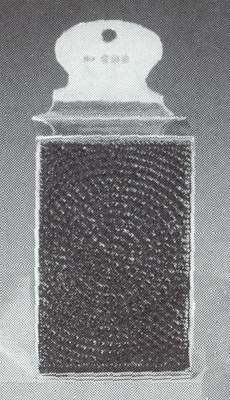
 In most cases were used 'kitchen' nutmeg graters of cylindrical or
semi-circular form with hinged base, divided interior and the top
recessed below the hoop handle. Other 'kitchen' nutmeg graters were
of upright rectangular form and shaped top panel pierced for
hanging.
In most cases were used 'kitchen' nutmeg graters of cylindrical or
semi-circular form with hinged base, divided interior and the top
recessed below the hoop handle. Other 'kitchen' nutmeg graters were
of upright rectangular form and shaped top panel pierced for
hanging.
|
However, small boxes suitable for carrying in
the pocket, and used to contain nutmeg, were in use since the 18th
century.
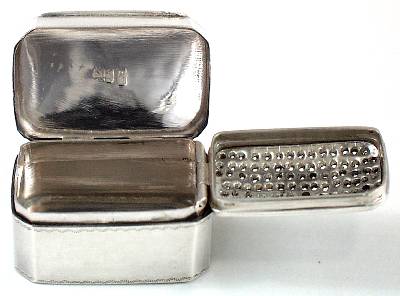
The nutmeg grater was usually a small silver container fitted with
an inner grate attached to the cover on the inside.
This permitted the dust to fall through into the box,
|
The graters were made on a great variety
of styles and shapes and were in use throughout the first half of
the Victorian era.
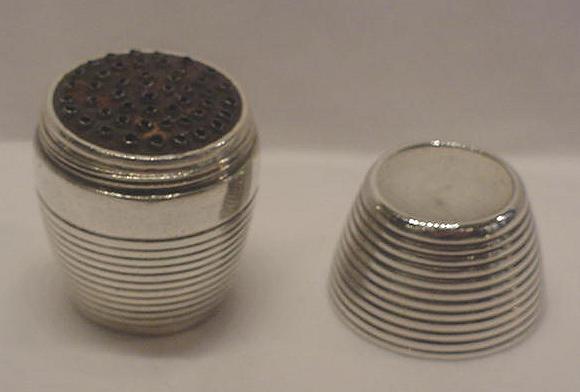 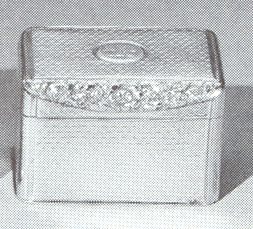 The most frequent shape was the rectangular form with hinged cover
and base, but also the barrel shape unscrewing at the center and
with a silver rimmed metal grater was highly popular.
The most frequent shape was the rectangular form with hinged cover
and base, but also the barrel shape unscrewing at the center and
with a silver rimmed metal grater was highly popular. |
Other popular items were octagonal, oval
and cylindrical shaped nutmeg graters
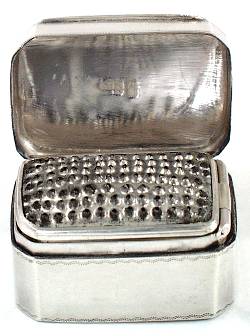
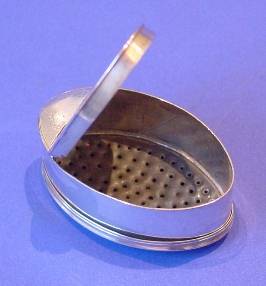
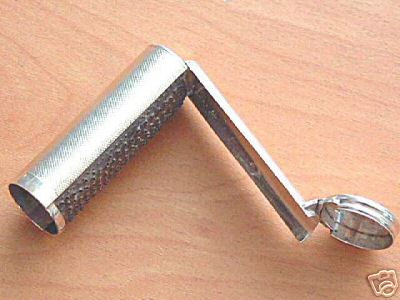
|
but also circular, egg, spade and urn shapes were widely used
Nutmeg graters were decorated with
geometric motifs, bands of foliage and rococo piercing and
engraving.
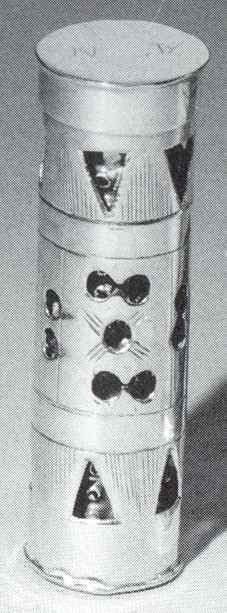
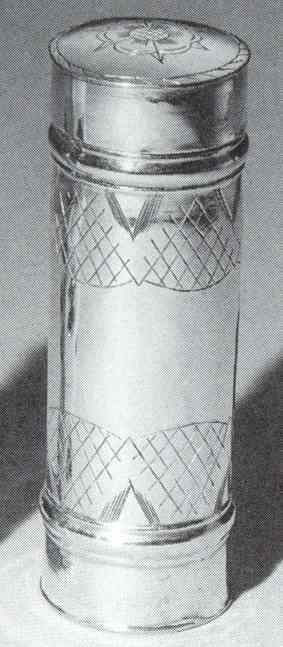
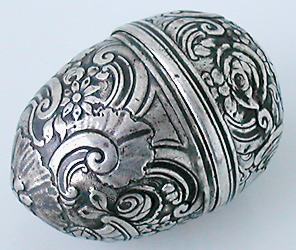
|
Sometimes the nutmeg grater was obtained by a
cowrie shell enclosed by silver straps with a silver hinged cover
pierced to form the grater.
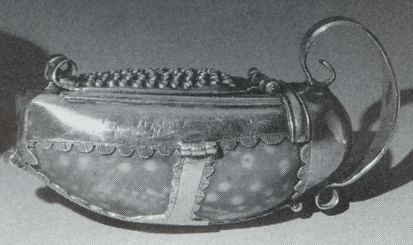
Usually this nutmeg graters had the straps with serrated leaf-tip
edges and a scroll handle. |
There's also examples of Staffordshire enamel
nutmeg graters.
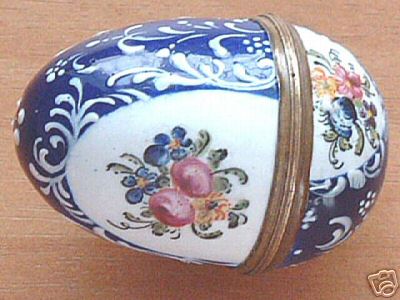
This is decorated with a blue background below white enamel, leaf
floral, scroll and shell designs. |
In other cases the grater had the shape of

nutmeg (chased with foliage) |
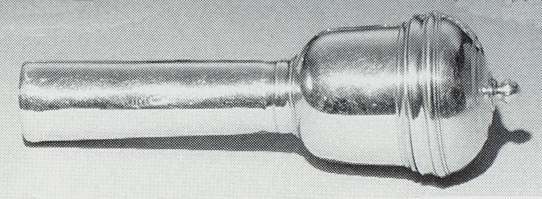 mace
(the acorn-shaped top is fitted with grater, the cylindrical stem
unscrewing to reveal an additional grater and corkscrew) mace
(the acorn-shaped top is fitted with grater, the cylindrical stem
unscrewing to reveal an additional grater and corkscrew) |

shallow boat with hinged grater-inset cover and hinged storage
compartment (maybe originally intended as snuff or tobacco rasp)
|
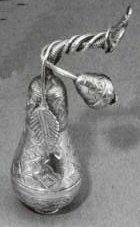 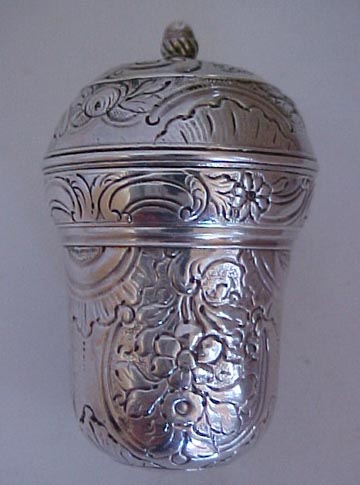
pear and acorn. |
As utilitarian objects nutmeg graters were used and abused and the
rare surviving examples in excellent conditions are greatly researched
by collectors.
Giorgio Busetto - © 2004 -
www.silvercollection.it
this article is published on  website website
|


























